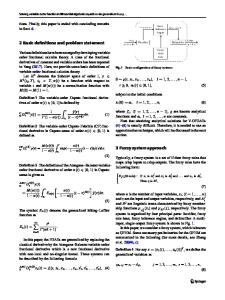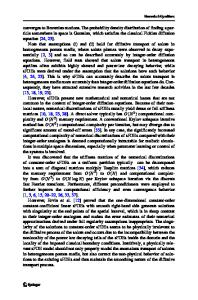Numerical solution of variable order fractional differential equations by using shifted Legendre cardinal functions and
- PDF / 1,424,950 Bytes
- 8 Pages / 595.276 x 790.866 pts Page_size
- 21 Downloads / 374 Views
ORIGINAL ARTICLE
Numerical solution of variable order fractional differential equations by using shifted Legendre cardinal functions and Ritz method Faezeh Sadat Yousefi1 · Yadollah Ordokhani1 · Sohrabali Yousefi2 Received: 29 June 2020 / Accepted: 3 October 2020 © Springer-Verlag London Ltd., part of Springer Nature 2020
Abstract In this paper, we present a new numerical method for solving variable order fractional differential equations, which is based on shifted Legendre cardinal functions. First, we obtain the pseudo-operational matrix of the variable order fractional derivative by applying the properties mentioned in the Caputo derivative of fractional variable order. Then, using Ritz method, the pseudo-operational matrix and collocation method, the problem is reduced to a system of algebraic equations that is solved by Newton’s iterative method. Illustrative examples are included to demonstrate the efficiency and accuracy of the proposed method. Keywords Variable order fractional differential equations · Pseudo-operational matrix of derivative · Shifted Legendre cardinal functions · Caputo derivative · Ritz method
1 Introduction Recently, fractional calculus describes many real-life phenomena such as hydrological models [1], medical [2], heat transfer model [3], dynamic modeling [4], finance [5], temperature and motor control [6]. These fractional equations include fractional differential equations, fractional optimal control problems, fractional partial differential equations, fractional partial integro-differential equations, the initial and boundary value problems. The important point to solve fractional equations is that to find the analytical solution of fractional equations is costly and difficult. Therefore, many researchers have noticed to solve them by numerical methods such as Chebyshev spectral method [7], CAS wavelet method [8], finite difference method [9, 10], finite element method [11], Tau method [12], * Yadollah Ordokhani [email protected] Faezeh Sadat Yousefi [email protected] Sohrabali Yousefi s‑[email protected] 1
Department of Mathematics, Faculty of Mathematical Sciences, Alzahra University, Tehran, Iran
Department of Mathematics, Faculty of Mathematical Sciences, Shahid Beheshti University, Tehran, Iran
2
Bernoulli wavelets [13], Legendre wavelets [14], fractional order Fibonacci-hybrid functions [15], homotopy analysis method [16], Laplace transform [17], Meshless method [18] and hat functions [19]. Firstly, in 1993 Samko and Ross investigated operators when the order derivative or integral is not constants. Eventually, they presented the concept of variable order (VO) integral and derivative so the order of the fractional operators is one of the feasible functions of space, time, and so on. Also, they expressed some of their properties. Therefore, they generalized the theory of fractional calculus that has many applications in various sciences, for instance in physics [20], modeling of viscoelasticity oscillators [21], petroleum engineering [22], mecha
Data Loading...











